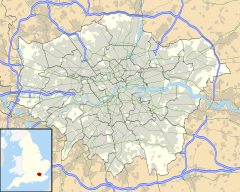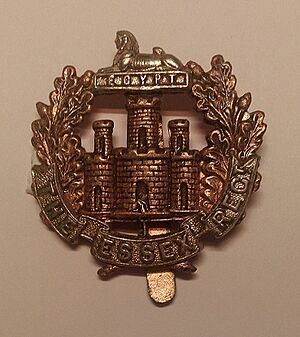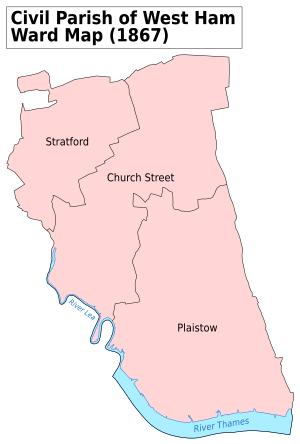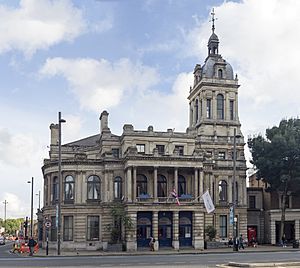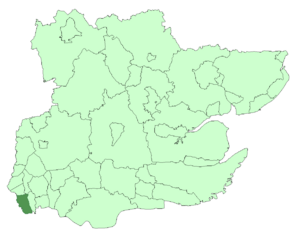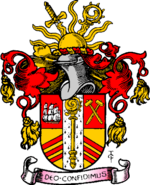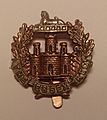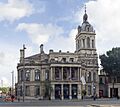West Ham facts for kids
Quick facts for kids West Ham |
|
|---|---|
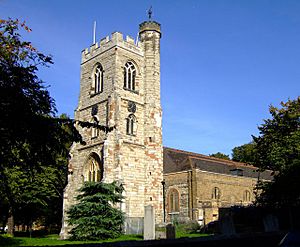 All Saints’ Church, serving the Ancient Parish of West Ham |
|
| Population | 15,551 (2011 Census, Ward) |
| OS grid reference | TQ405837 |
| • Charing Cross | 6.1 mi (9.8 km) WSW |
| London borough | |
| Ceremonial county | Greater London |
| Region | |
| Country | England |
| Sovereign state | United Kingdom |
| Post town | LONDON |
| Postcode district | E15 |
| Dialling code | 020 |
| Police | Metropolitan |
| Fire | London |
| Ambulance | London |
| EU Parliament | London |
| UK Parliament |
|
| London Assembly | |
West Ham is a busy area in East London, England. It is part of the London Borough of Newham. This inner-city area is about 6.1 miles (9.8 km) east of Charing Cross, a central point in London.
West Ham is located right next to the River Lea. It started as an old parish, which is like a local church area, serving parts of the older Manor of Ham. Later, it became a County Borough, which was a special type of local government area. West Ham was part of the historic county of Essex. It kept its boundaries mostly the same from the 1100s until 1965. Then, it joined with nearby areas to form the western part of the new London Borough of Newham.
Historically, West Ham was important for its docks and sea trade. It was even called the Factory centre of the south of England because of its many industries. Most of these jobs are gone now. However, the area has been rebuilt and improved, partly because of the 2012 Summer Olympics held nearby.
Contents
History of West Ham
What's in a Name?
The name 'Hamme' was first written down in 958. This was in an old Anglo-Saxon document. King Edgar gave the Manor of Ham to a leader named Ealdorman Athelstan. At that time, Ham was not divided. Later, in 1037, another document mentioned land that is now East Ham. This shows that the area was split into parts between 958 and 1037.
The name 'Ham' comes from an old English word. It means 'a dry piece of land between rivers or marshland'. This describes West Ham's location well. It is surrounded by the River Lea, River Thames, and River Roding, and their marshy areas. The area of North Woolwich was likely separated from Ham after the Norman Conquest.
The name 'Westhamma' was first used in 1186. This was to show it was different from Ham or East Ham. The building of Stratford Langthorne Abbey, a large monastery, helped the area grow. Also, Bow Bridge was built. It was the only dry way to cross the Lea River for many miles. These things likely made West Ham more successful.
Old Times: Tudor and Stuart Eras
In June 1648, during a time of wars in England, a group of Royalist soldiers fought a small battle. About 500 to 600 men defeated the Tower Hamlets Militia at Bow Bridge. They then took over Stratford for three days. After that, they marched along an old Roman road to the Siege of Colchester.
West Ham Grows into a Town
The village of West Ham grew very quickly after 1844. This was because of the Metropolitan Building Act. This law stopped dangerous factories from working in the main city area. The River Lea was the eastern border of this area. So, many factories moved to the other side of the river, into West Ham. At that time, West Ham was a parish in Essex, centered around All Saints Church, West Ham.
Because of this, West Ham became a major place for making medicines, chemicals, and food in Victorian Britain. It grew so fast that people called it "London over the border." In 1886, a newspaper called The Times wrote about this growth. It said that many factories were built in Stratford and Plaistow. When the Victoria and Albert Docks were built in Canning Town, West Ham became a very important center for manufacturing and trade. This brought many hard-working people to the area.
First World War: The West Ham Pals
During the First World War, the Mayor and Borough of West Ham created a special group of soldiers. These were called a "pals battalion." Local volunteers joined this group, known as the 13th (Service) Battalion (West Ham) of the Essex Regiment. A similar group was also formed in East Ham.
The West Ham Pals fought on the Western Front. They were part of the 6th Infantry Brigade of the 2nd Infantry Division. Later, the British Army needed more soldiers for other units. So, the West Ham battalion was broken up, and its remaining members joined other groups.
Second World War
West Ham was heavily bombed during the Second World War. This was because it had important targets like the Royal Docks and railway lands in Stratford. These were valuable places that the enemy wanted to destroy. Many buildings were damaged, and people were sadly affected.
After the Wars
In the 1970s and 1980s, West Ham lost many of its industries. Factories and large workplaces closed down. This included the Bromley gasworks and West Ham Power Station. This period is known as deindustrialisation.
How West Ham Was Governed
Local Government: The Old Parish
West Ham was once a large old parish. It covered about 4,500 acres (18 km2) in the Becontree area of Essex. The parish was divided into three parts: Church-street, Stratford-Langthorne, and Plaistow. The small village of Upton was also part of this parish.
Local Government: The County Borough
In 1889, West Ham had enough people to become a county borough. This meant it was no longer controlled by the Essex County Council, even though it was still officially in Essex. By 1901, it was the ninth most populated area in England, with 267,308 people.
From 1934 to 1965, West Ham was surrounded by other areas. To the east was the County Borough of East Ham. To the north were Wanstead and Woodford, and Leyton. To the west was Poplar. The Thames River was to the south, with Greenwich on the other side.
West Ham's Coat of Arms
West Ham received its coat of arms on January 14, 1887. The zig-zag lines at the bottom represent Stratford. They come from the symbol of Stratford Langthorne Abbey. At the top right, there are crossed hammers. These hammers are also on the badge of West Ham United. They represent the Thames Ironworks and Shipbuilding Company, which was a major employer in the area. The ship on the arms shows the Royal Docks and West Ham's long connection to the sea. The Latin words "Deo Confidimus" at the bottom mean "In God We Trust."
Joining Greater London
People started talking about West Ham joining London in 1855. West Ham Council thought about joining the County of London in 1895 and 1907. But they were not keen to join. They worried about higher taxes and how London's planning rules might affect their industries. They also wanted to keep their own local government and special status.
A group called the Royal Commission looked at how local government worked in the Greater London area. In 1965, a new law called the London Government Act 1963 was passed. This law ended the county borough of West Ham. It also ended the County Borough of East Ham. Their areas, along with small parts of Barking and Woolwich, were combined. This created the new London Borough of Newham in Greater London.
Geography of West Ham
West Ham is located east of the Lea River and north of the Thames River. Leyton is to its north, and East Ham is to its east. The border between West and East Ham used to run from a lost forest area in the north. It went along Green Street down to a small, lost natural harbor called Ham Creek.
The area of West Ham includes more than just the central part south of Stratford. It also covers sub-areas like Stratford, Canning Town, Plaistow, Custom House, Silvertown, Forest Gate, and the western parts of Upton Park. Upton Park is shared with East Ham.
The parts of West Ham along the Lea and Thames rivers were historically industrial. The rest of the area was mostly homes. These were often Victorian terraced houses. There were also many social housing buildings built after the wars. Since it became a town, West Ham has often been one of the poorer areas in London.
People and Cultures
In 1971, about 16% of the people in West Ham were from non-European backgrounds. This number grew to about 30% by 1991. By 2011, it was 65.5%. In 2011, about 19% of the people in the ward were White British. Around 15% were from other White backgrounds.
Getting Around: Transport
West Ham station is on Manor Road. It used to be called The Boleyn Ground. You can catch several trains there. These include the London Underground Jubilee, Hammersmith & City, and District tube lines. You can also use the National Rail c2c services. Since 2010, the Docklands Light Railway also serves the station. Plaistow and Stratford stations are also nearby.
Sports in West Ham
The football club West Ham United F.C. is named after this area. Their nicknames are the Irons and the Hammers. These names come from their connection to the Thames Ironworks and Shipbuilding Company. Workers from this company formed the original team, Thames Ironworks F.C.. West Ham United F.C. played at the Boleyn Ground in nearby Upton Park from 1904 to 2016.
There was also the West Ham Stadium. This stadium was used for football, greyhound racing, and speedway races. It operated from 1928 to 1972 and could hold 120,000 people. The streets built on the old stadium site are named after famous speedway riders. These include Bluey Wilkinson and Jack Young. The West Ham Hammers speedway team raced in top leagues from 1929 to 1939, 1946 to 1955, and 1964 to 1971. They won the first British League in 1965.
While football is very popular, West Ham also has rugby. Holland Road, near West Ham station, is home to three rugby teams. They play in the Essex RFU leagues. These teams are Phantoms RFC, Kings Cross Steelers, and East London RFC.
Famous People from West Ham
Many notable people have connections to West Ham:
- Frank Bailey (1925–2015), a firefighter
- Leslie Bray (1895–1957), a cricketer and officer
- Sol Campbell, a famous footballer
- Tony Cottee, a footballer
- Alan Curbishley, a footballer and football manager
- George Edwards (1694–1773), an ornithologist (someone who studies birds)
- David Essex, a musician
- Elizabeth Fry, a social reformer known for helping prisoners
- Len Goulden, a footballer
- Leon Greene, an opera singer and actor
- Chris Hughton, a footballer and football manager
- Ronnie Irani, a cricketer
- Rob Lee, a footballer
- Jack Leslie, a footballer
- Lennox Lewis, a boxer and former world heavyweight champion
- Linda Lewis, a singer, songwriter, and musician
- Joseph Lister, a surgeon who pioneered antiseptic surgery
- Glen Murphy, an actor and producer
- Mark Noble, a footballer
- Christine Ohuruogu, an athlete
- Daisy Parsons, a suffragette and West Ham's first woman Mayor
- Martin Peters, a footballer and World Cup winner
- Colin Towns, a composer and keyboardist
- Margaret Tyzack, an actress
- Reg Varney, an actor
- Steve Harris, a musician
Images for kids
See also
 In Spanish: West Ham (Londres) para niños
In Spanish: West Ham (Londres) para niños


